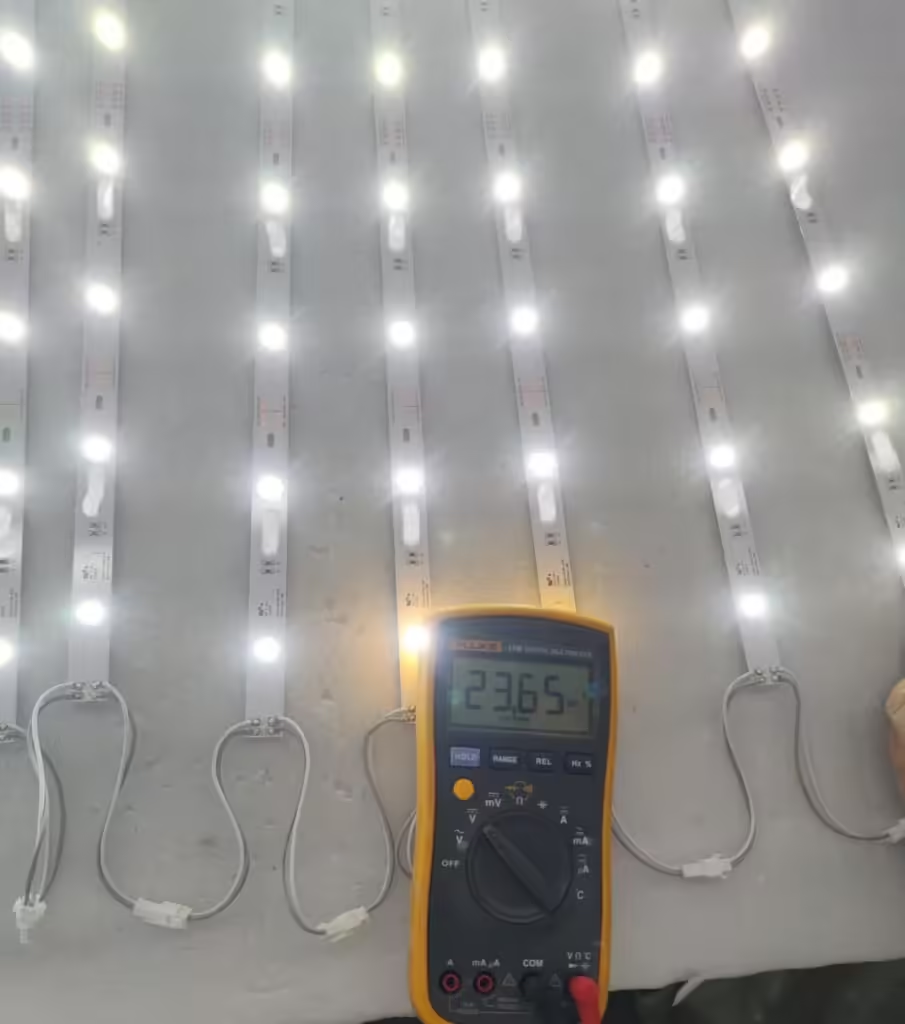Клубника больше не просто сезонный фрукт — благодаря современным методам выращивания ее можно выращивать круглый год в теплицах и крытых фермах. Одной из ключевых технологий, позволяющих это сделать, является использование светодиодных ламп для выращивания. Предоставляя правильный спектр и интенсивность света, производители могут улучшить цветение, повысить урожайность и повысить качество плодов даже в сезоны при слабом освещении. Но одного освещения недостаточно. Успешное выращивание клубники также зависит от тщательного контроля температуры, влажности, питательных веществ и опыления. Для коммерческих производителей понимание того, как сбалансировать эти факторы, необходимо для последовательного производства высококачественных фруктов.
Зачем использовать светодиодные лампы для выращивания клубники?
1. Снижение естественного освещения с помощью точного дополнительного освещения
В зимнем-сером северной Европе или в высоких широтах Канады короткие дни и облачный покров могут ограничить фотосинтез. Светодиодные лампы для выращивания клубники дают производителям надежный источник дополнительного освещения, поддерживая контролируемый фотопериод и стабильный ежедневный интеграл света. Тонкая настройка интенсивности почасово, растения остаются в соответствии с графиком, а не останавливаются в пасмурном небе или температуре.
2. Направленный световой спектр клубники для более быстрого и эффективного роста
Светодиодные светильники с высоким PPFD позволяют производителям настраивать световой спектр клубники, богатый синим (430-460 нм) и красными (640-660 нм) фотонами, а также регулируемым дальним красным цветом. Эти длины волн максимально увеличивают поглощение хлорофиллов и проталкивают растения через вегетативную фазу, укорочивая общий цикл роста и запуская более раннее, более равномерное цветение.
3. Премиум клубника с меньшим количеством вредителей
Сбалансированные, прохладные светодиоды обеспечивают жесткий контроль влажности, который сдерживает давление Botrytis и мучнистой росы, что приводит к меньшему количеству химических распылений. В то же время настроенный спектр повышает содержание растворимого раствора, углубляет красную пигментацию и усиливает аромат, придавая фруктам цвет, сладость и усиленный вкус, которые завоевывают место на полке и лояльность потребителей.

4. Более высокая урожайность и более высокая рентабельность инвестиций в коммерческое производство клубники
Клубника — это очень ценная, быстроразвивающаяся урожайность, поэтому прирост продукции приводит к прибыли. Энергоэффективные светодиоды (СИЗ ≥ 2,8 мкмоль/Дж) снижают затраты на электроэнергию, в то время как их однородность спектра увеличивает вес плодов и количество плодов на растение. Промышленные испытания в коммерческих клубниках регулярно показывают 15–30 % более высокую урожайность и более высокую окупаемость, обеспечивая привлекательный ROI светодиодного освещения для профессиональных производителей.
Какой спектр нужен клубнике для оптимального роста?
Клубника, как и большинство плодоносящих культур, сильно реагирует на определенные длины волн света. Каждая часть светового спектра играет уникальную роль в развитии растений, от раннего вегетативного роста до цветения и созревания плодов.
Синий свет (430–460 нм)
Синий свет поддерживает вегетативный рост, помогая строить компактные растения с сильными корнями и здоровыми листьями. Он также регулирует устьичное открытие, повышая эффективность воды и поглощая питательные вещества.
Красный свет (640–660 нм)
Красный свет необходим во время цветения и плодоношения. Он способствует развитию цветения, увеличивает размер плодов и ускоряет созревание. Сильный красный компонент имеет решающее значение для высокоурожайного производства клубники.
Дальний красный свет (710–730 нм)
Дальний красный свет влияет на сроки цветения и может повлиять на растяжение растений. В контролируемых количествах он может помочь синхронизировать цветочную конструкцию и улучшить однородность плодов.
Зеленый свет (500–570 нм)
Хотя и менее поглощен, зеленый свет проникает глубже в полог и поддерживает нижние листья, способствуя общему фотосинтезу и балансу растений.
Рекомендуемое соотношение спектра для общего выращивания клубники:
Сбалансированный светодиодный светильник для выращивания клубники, как правило, включает в себя:
Синий: 15–20%
Красный: 60–70%
Дальний красный: 5–10%
Зеленый/белый: 10–15% (для улучшения видимости и полного покрытия)
Такое сочетание обеспечивает сильный вегетативный рост, эффективное цветение и улучшение качества плодоовощ.
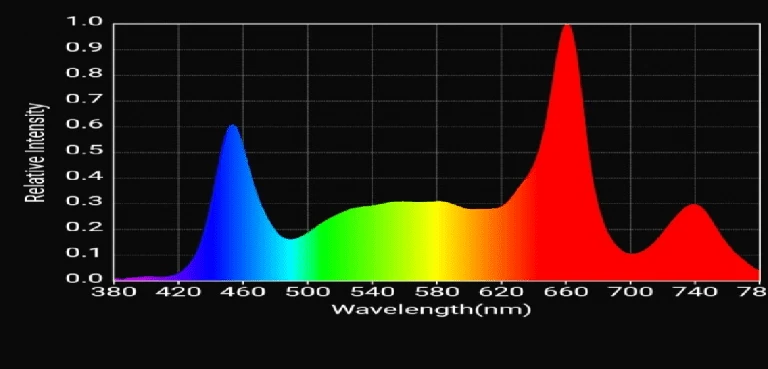
Рекомендации по индивидуальному спектру по типу клубники:
Дневная клубника (например, Альбион, морская морская прогулка):
Поддержите более высокое соотношение красного и синего (~4:1) с добавлением дальнего красного цвета, чтобы стимулировать непрерывное цветение и быструю езду на велосипеде.
Сорта короткого дня (например, Chandler, Camarosa):
Получите выгоду от умеренного красного света с усиленным синим (отношение ~3:1) для усиления вегетативного роста перед стадией цветения.
Вечноносые сорта в вертикальных фермах:
Может потребоваться более высокое содержание синего (~25%), чтобы сохранить компактные растения в системах с ограниченным пространством, при этом сохраняя при этом ярко-красный цвет.
Регулируя световой спектр в соответствии с типом клубники и системой выращивания, производители могут оптимизировать урожайность, сокращать циклы роста и повышать качество плодов при выращивании под светодиодом.
Основные характеристики, которые нужно искать в светодиодных светильниках для выращивания клубники
Правильный выбор светодиодных ламп имеет решающее значение для достижения стабильной и высококачественной клубники в коммерческих операциях. Вот пять основных особенностей, которые профессиональным производителям следует учитывать:
1. Высокая эффективность (PPE ≥ 2,8 мкмоль/Дж)
Эффективность фотосинтеза фотонов (PPE) измеряет, насколько эффективно свет выращивания преобразует электрическую энергию в пригодные для роста фотоны для роста растений. Для клубники, которая легко жаждущей вегетативной и плодоносящей, 2,8 мкмоль/Дж или выше обеспечивает более низкие затраты на энергию при сохранении сильного роста. Высокоэффективные светодиодные светильники для выращивания снижают операционные расходы и со временем повышают рентабельность инвестиций, особенно в крупномасштабных проектах по выращиванию клубники.
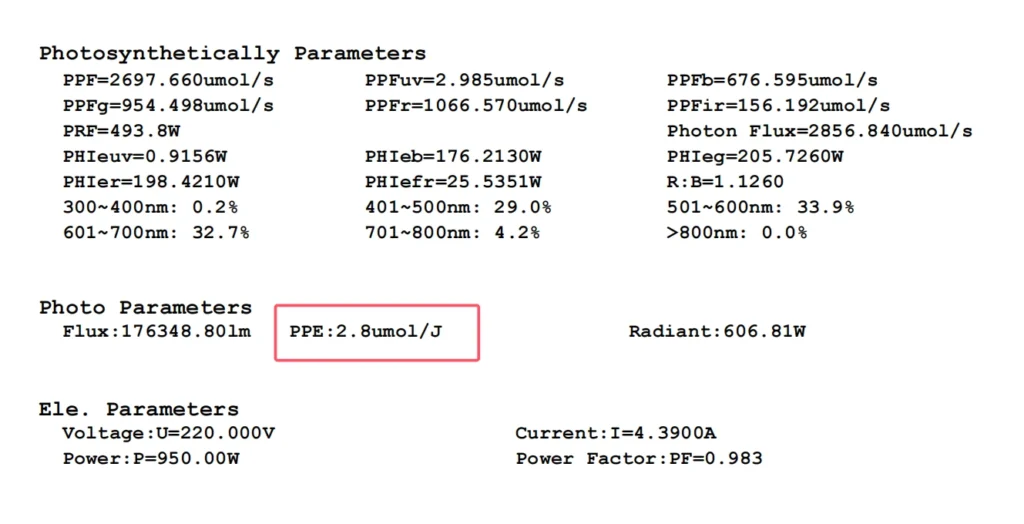
2. Равномерное PPFD и световое распределение
Фотосинтезирующая плотность потока фотонов (PPFD) определяет, насколько свет достигает полога растения. Для даже развития плодов PPFD должен быть одинаковым в районе выращивания с минимальными горячими точками или падениями. Неравномерное освещение приводит к нерегулярному цветению и переменному качеству плодов. Хорошо разработанная светодиодная система с равномерным распределением света гарантирует, что каждое клубничное растение получает оптимальное освещение, повышая общую производительность.
3. Подходящая мощность, основанная на высоте установки
Производители клубники часто используют многослойные или тепличные системы. Мощность светодиодного индикатора выращивания (измеряется в ваттах) должна соответствовать высоте установки и интервалу между установками. Например, приспособление мощностью 200 Вт–400 Вт может быть идеальным для вертикальных стойки 30–60 см, а 600–800 Вт — теплицы для теплиц. Немощные лампы не обеспечивают требуемую PPFD, а сверхмощные могут тратить энергию или вызывать стресс листа.
4. Диммируемые и настраиваемые спектры
Функции затемнения позволяют производителям регулировать интенсивность света на разных стадиях роста — низкая для раннего вегетативного роста, высокая при цветении и плодоношение. Более совершенные системы обеспечивают настраиваемость спектра, обеспечивая целенаправленную регулировку длины волны (например, повышение красного во время плодоношения) для максимального выхода клубники и качества. Эти гибкие системы освещения адаптируются к различным сортам клубники и средам роста, что делает их идеальными для точного земледелия.
5. Совместимость цепи DAISY для централизованного управления
В коммерческой клубнике управление сотнями света по отдельности неэффективно. Светодиодные лампы для выращивания, поддерживающие цепочку ромашки, связывающие несколько устройств в единую систему управления, позволяют синхронизировать диммирование, планирование и спектральную настройку. Централизованный контроль повышает эффективность использования энергии, снижает рабочую силу и обеспечивает равномерное развитие сельскохозяйственных культур во всех зонах выращивания.

Выбирая светодиодные лампы для выращивания с высоким PPE, однородным PPFD, регулируемой мощностью и интеллектуальными возможностями управления, производители клубники могут оптимизировать свою среду выращивания как для выхода, так и для качества, что является ключом к конкурентоспособности в современном ландшафте садоводства.
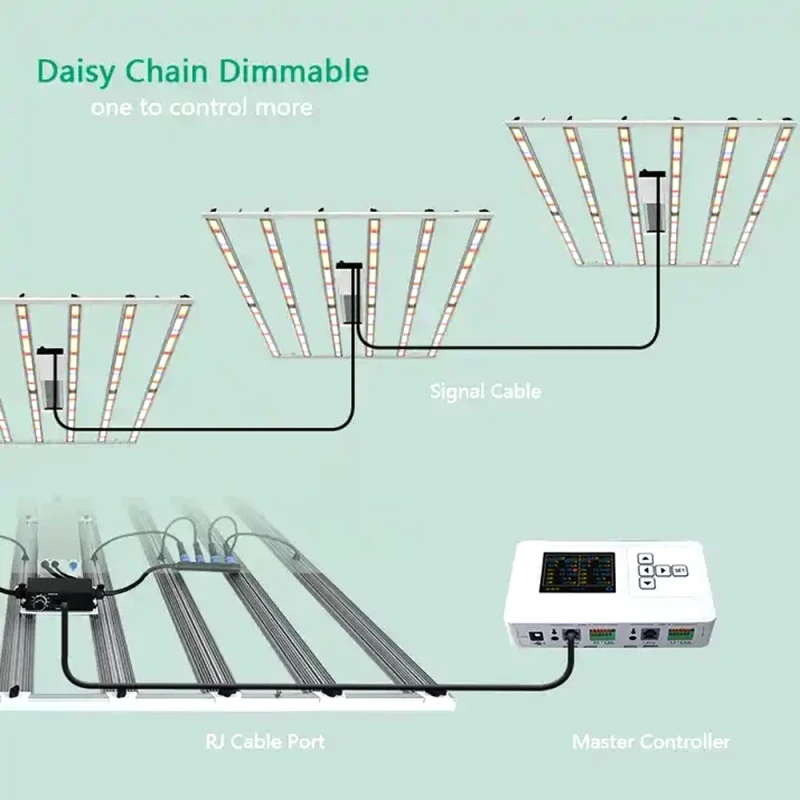
Помимо освещения: другие ключевые факторы успешного выращивания клубники в помещении
В то время как светодиодные лампы для выращивания играют решающую роль в современном выращивании клубники, одно только освещение не может гарантировать высокую урожайность или качество плодов премиум-класса. Для стабильного успеха в теплицах и в помещении производители также должны управлять несколькими другими факторами окружающей среды и выращивания. Вот основные соображения:
1. Контроль температуры и влажности
Клубника процветает при температуре от 18 до 24°C (64–75°F) днем и немного прохладнее ночью. Если температура становится слишком высокой, растения могут прекратить цветение или давать неправильные плоды. В то же время поддержание относительной влажности между 60–70% помогает снизить риск таких заболеваний, как Botrytis (серая плесени). Светодиодные лампы для выращивания создают минимальное лучистое тепло, что упрощает регулирование климата без нагрузки на растения.
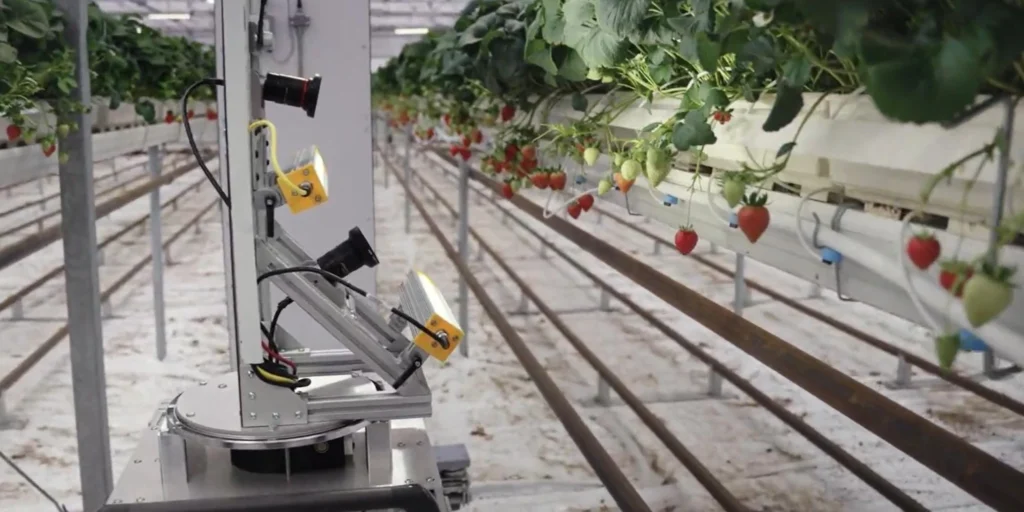
2. Управление опылением
В отличие от листовой зелени, клубника требует опыления, чтобы сформировать хорошо фасонные плодотворные плоды. В теплицах это часто связано с использованием шмелей или инструментов ручного опыления. Также полезны правильный поток воздуха и легкая вибрация цветов. Светодиодное освещение обеспечивает стабильное цветение, что, в свою очередь, позволяет проводить более предсказуемые циклы опыления.
3. Доставка питательных веществ и выбор субстрата
Клубника чувствительна как к дисбалансу питательных веществ, так и к корневым условиям. Многие производители выбирают безпочвенные субстраты, такие как кокосовая волокна, каменная вата или гидропонные системы, чтобы обеспечить стабильную корневую среду. Точная дозировка питательных веществ, особенно с кальцием, калий и магнием, необходима для упругости фруктов, вкуса и срока годности. Автоматизированные системы фертигации часто используются в коммерческих установках.
4. Циркуляция воздуха и CO2 ровные
Хорошее движение воздуха предотвращает накопление влаги вокруг листьев и цветов, что снижает риск заболевания. В закрытых условиях системы активной вентиляции и горизонтальные вентиляторы помогают поддерживать даже температуру и влажность. Кроме того, поддержание CO2 Уровни около 800–1000 частей на миллион могут улучшить фотосинтез и повысить урожайность плодов в сочетании с высоким светодиодным освещением PPFD.
5. Плотность растений и системы поддержки
Перенаселенность может привести к плохому воздушному потоку, световой закупорке и неравномерному плодоношению. Хорошо спланированная планировка — будь то вертикальные стойки или горизонтальные ряды — гарантирует, что каждое растение получает достаточно света и пространства. Для плодоносящих сортов использование опорных проводов или шпалер помогает поддерживать приподнятую клубнику и уменьшает кровоподтеки или гниль от контакта с землей.
Сочетая профессиональные светодиодные лампы для выращивания с точным контролем окружающей среды, управлением питательными веществами и стратегиями опыления, производители могут создать идеальную обстановку для клубники. Такой комплексный подход является ключом к достижению стабильных и высококачественных урожая круглый год.
Обзор мирового рынка выращивания клубники
Клубника является одной из самых широко потребляемых ягод в мире, с растущим спросом, обусловленной их вкусом, пользой для здоровья и универсальностью в свежих и обработанных продуктах. По мере увеличения мирового потребления растет и потребность в более эффективных методах выращивания круглогодичных, включая теплицу и крытое сельское хозяйство, поддерживаемые светодиодными огнями для выращивания.

1. Основные регионы, производящие клубнику
Такие страны, как Китай, США, Мексика, Испания и Турция, доминируют в глобальном производстве клубники. Общий объем Китая лидирует, а США и Мексика являются основными экспортерами в Северную Америку. В Европе Испания является ведущим производителем и поставщиком, особенно в зимний сезон. В настоящее время эти регионы внедряют технологии контролируемого сельского хозяйства (СЭА) для повышения эффективности производства и удовлетворения спроса в межсезонье.
2. Рост спроса на круглогодичное предложение
Поскольку потребители ожидают, что клубника будет доступна в течение года, особенно в Северной Америке, Европе и некоторых частях Азии, производители обращаются к теплицам, вертикальным фермам и светодиодным системам выращивания для стабилизации производства. Светодиодное освещение обеспечивает стабильную выходную емкость даже в условиях низкой освещенности или зимних месяцев, что помогает снизить зависимость от импортных фруктов и сокращает цепочки поставок.
3. Переход в сторону крытых и городских сельского хозяйства
В городских центрах и районах с ограниченной пахотной землей набирает обороты крытая земляника с использованием гидропонных или аэропонных систем. Такие страны, как Япония, Нидерланды и ОАЭ, инвестируют в высокотехнологичные крытые фермы, где клубника выращивается при полном спектре светодиодных освещениях. Ожидается, что эта тенденция будет расти в ответ на изменение климата, нехватку воды и потребность в местном производстве продуктов питания.
4. Экономические возможности для производителей и дистрибьюторов
Клубника — это высокомаржа, особенно когда она продается свежими или в качестве органических фруктов премиум-класса. Принимая передовые системы светодиодного освещения и систем контроля окружающей среды, производители могут повысить как урожайность, так и качество плодов, повышая прибыльность. Дистрибьюторы и оптовики выигрывают от стабильного, межсезонье и лучшего срока годности. Это делает коммерческое выращивание клубники с светодиодными фонарями для выращивания в качестве отличной возможности для бизнеса как на развитых, так и на развивающихся рынках.
5. Прогноз рынка и внедрение технологий
Согласно отраслевым отчетам, ожидается, что мировой рынок клубники будет неуклонно расти в течение следующих пяти лет, при этом все большее количество продукции будет перейти в контролируемую среду. Технология LED Grow Light является ключевым фактором, способствующим этому переходу, предлагая энергоэффективные масштабируемые решения, адаптированные к ягодным культурам. Производители и поставщики, которые поддерживают кастомизацию и техническое руководство, имеют хорошие возможности для обслуживания этого расширяющегося сегмента.
Благодаря сильному рыночному спросу, благоприятной экономике и быстро развивающимся технологиям выращивание клубники под светодиодными лампами для выращивания станет глобальным стандартом для современного производства фруктов.
Пример: как светодиодные лампы для выращивания улучшают урожайность и качество клубники
По мере того, как все больше производителей используют светодиодные лампы для выращивания клубники, результаты реальных результатов демонстрируют ценность оптимизированных систем освещения для повышения урожайности, качества фруктов и общей эффективности работы. Вот ключевые результаты, наблюдаемые в коммерческих проектах клубники с использованием высокопроизводительных светодиодных ламп:
1. Повышенная урожайность и более быстрые циклы
В контролируемых условиях переключение с традиционного освещения HPS на светодиодные лампы для выращивания полного спектра с высоким уровнем СИЗ (≥2,8 мкмоль/Дж) привели к увеличению урожайности на 15–301 т.д. при целевом красном и синем свете растения раньше и более равномерно снижали общий цикл посева на 7–10 дней. Для производителей с несколькими циклами посадки в год это может значительно увеличить годовой объем производства.
2. Улучшенное качество фруктов
Светодиодное освещение позволяет точно контролировать спектр и интенсивность света, что напрямую влияет на уровень Брикса (содержание сахара), твердую стойкость и цвет. В одном теплице в Северной Европе клубника, выращенная под настраиваемым светодиодным спектром, показала более насыщенную красную окраску и более сильный аромат, что сделало их более привлекательными для ритейлеров высокого класса. Размер плодов также стал более однородным, повышая рентабельность.
3. Снижение заболеваемости
Охладительные светодиодные лампы для выращивания снижают избыточное количество тепла и позволяют лучше управлять влажностью. Это помогает ограничить распространение распространенных грибковых заболеваний, таких как Botrytis cinerea, особенно в системах с высокой плотностью. Некоторые производители сообщили о сокращении потерь урожая на 30–40% по сравнению с предыдущими установками с использованием традиционного освещения.
4. Оперативная эффективность и гибкость
Производители, использующие диммируемые и цепные светодиодные лампы для выращивания, получают выгоду от централизованного управления, более простых планирования и снижения требований к рабочей силе. В одной вертикальной ферме в Японии использовались приспособления, настраиваемые спектром, для настройки световых рецептов для различных сортов клубники на разных стадиях роста — все это управляемо одним контроллером. Эта гибкость улучшила как производительность, так и операционную эффективность.
5. Пример из реального мира от коммерческого производителя
Американская крытая ферма, выращивающая дневную нейтральную клубнику (например, Альбион), переключилась на светодиодные лампы для выращивания, предоставленные SignLite. Оптимизируя спектр красно-синего-даль-красного цвета и используя диммируемые функции на разных стадиях роста, ферма добилась:
28% Увеличение урожайности за м²
2-недельное сокращение среднего времени цикла
95%+ рыночная ставка фруктов
Энергосбережение более 30% по сравнению с HPS
Эти результаты подчеркивают, как светодиодные светильники при правильном выборе и интегрировании в систему контролируемого культивирования могут изменить экономику и качество производства клубники, особенно для производителей, ориентированных на рынки премиум-класса или в межсезонье.

Где купить профессиональные светильники для выращивания клубники оптом
Выбор правильного поставщика света так же важен, как и правильный спектр. Для коммерческого выращивания клубники важно работать с производителем, который понимает как требования к садоводству, так и потребности в конкретных проектах. на Signlite (Kingrowlights), мы специализируемся на высокоэффективных светодиодных светильниках для выращивания, предназначенных для плодоношения таких культур, как клубника. С более чем 15-летним опытом, собственными исследованиями и разработками и послужным списком мировых проектов мы предлагаем настраиваемые решения — нужны ли вам стандартные светильники с полным спектром или настраиваемые системы для современных крытых ферм.
Хотите масштабировать производство клубники с помощью надежного освещения?
Свяжитесь с нашей командой сегодня для оптовых цен, технических консультаций или для запроса образцов для тестирования.
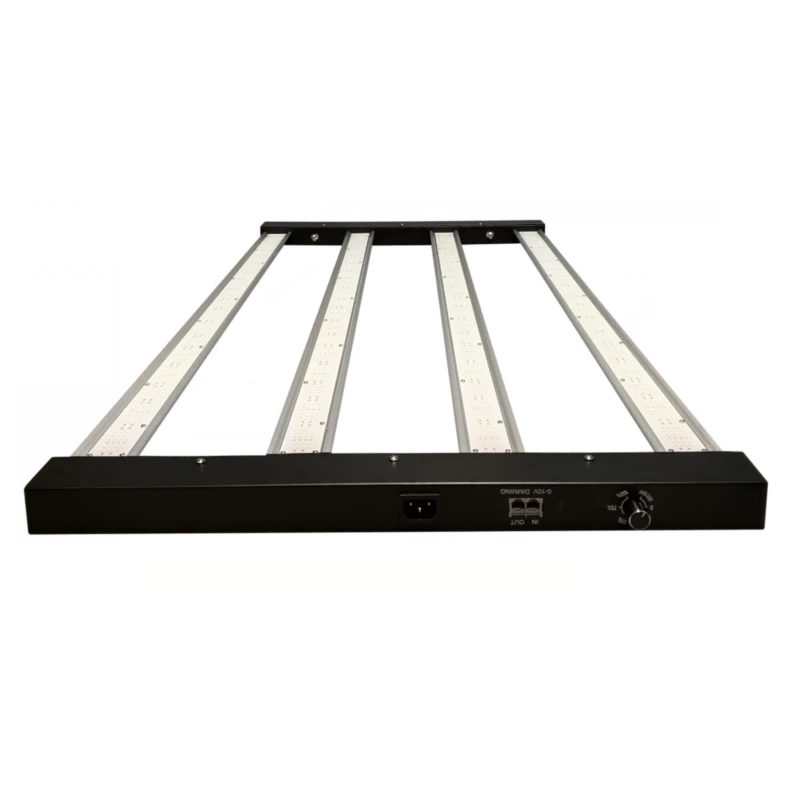
Складные светодиодные лампы для выращивания растений 1000 Вт 5x8 футов с покрытием сердечника и УФ-ИК-излучением
- Полный спектр для клубники, 60% RED+ 20% Blue+ 20% белая и ИК-
- 4 бара с 1 м друг от друга, для однородного PPFD
- Высокая СРП, до 3,0м.м./Дж
- Складное приспособление легко транспортировать, хранить и устанавливать, экономя расходы
- Дизайн цепи ромашки, доступный несколько контроль
- Предоставить настраиваемое решение
- 5 лет гарантии




